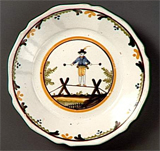by Pascal Jacob
From the early 19th century, the circus was an endless source of inspiration for designers in the decorative arts. The popularity of trick riders, clowns, and lion tamers encouraged potters, woodworkers, toymakers and fashion designers to work with a dynamic artistic form in constant expansion. Artisanal creativity was overflowing and shop windows were filled with objects made from porcelain, wood, Babbitt metal and bronze. There was a probably a fashion effect that manufacturers made the most of in several European countries. Porcelain makers from Staffordshire took up the early glories of the circus and crafted effigies of Grimaldi, Andrew Ducrow and Isaac van Amburgh, and these colourful statuettes decorated mantelpieces, consoles and pedestal tables, like costly derivatives. They were a forerunner to the bronze figurines sold by the Cirque du Soleil in multiple sales points in their big tops and theatres.
The taste for these, regardless of their size, goes back a along way. From the mid-nineteenth century onward, the chisels of Pradier, Fratin, Villanis, Manière and Barye cast pretty figures in bronze, destined to decorate bourgeois homes, and moreover, to maintain the fascination for these uncommonly talented men and women. Mostly anonymous clowns, acrobats, and horsemen, chosen above all for their generic appeal, were powerful evocations of an unchanging circus. The potters and porcelain artists were the first to take an interest in a decorative register that enabled then to move into the intimate realm of the meal: plates, jugs, mustard pots, and sugar bowls piled up on dressers and in cupboards before decorating tables and buffets. The Gien factory represented Franconi's exercises on a lemon yellow background, mainly for a sumptuous punch service. Creil and Montereau decorated a magnificent series of plates in bi-colour and polychrome, illustrated with drawings by the painter and illustrator Victor Adam. Choisy decorated "amusing" plates with riddles illustrated by acrobats and clowns, or describing the fairground pleasures. Each was more original than the last in combining the arts of the circus ring with tableware. Festive and popular objects, these colourful, sometimes naive utensils helped make the circus come to life beyond the usual performances.
Die-cuts
Die-cuts are small cardboard silhouettes meticulously cut out and varnished, sometimes fully embossed, sometimes enriched with a slight embossing that gives them relief and structure. Contemporary with the invention of chromolithography in 1837 by the Mulhouse printer and lithographer Godefroy Engelmann (1788-1839), this technique is similar to the principle of both cut-out shadow puppets and decals. Die-cut production developed during the second half of the 19th century, mainly in Berlin in Germany until 1900, but also in other European countries (France, Norway, England, Sweden, Hungary, Austria, the Netherlands and Denmark) and the United States.
Companies like Hagelberg-Berlin, Vallet-Minot and McLoughlin Bros. (NY), produced millions of these little figures, which were sometimes glued to small wooden supports for use as toys. Die-cuts were also used in the decorative arts to embellish lamps and furniture in the spirit of 18th century Venetian collages, and to decorate urns and baubles using the glass painting technique.
The endlessly varied themes ranged from nature to the inventions of the time. Flowers, mushrooms, fruit, birds, butterflies, sailboats, locomotives, submarines and aircraft rivalled each other in terms of refined and virtuosic designs. Meanwhile, the circus provided a marvellous pretext to illustrate an ever more brilliant and colourful plethora of clowns, acrobats, horsemen and trained animals, especially in Victorian England. Some remarkable acts were also celebrated in die-cuts, like this cycling elephant: a training feat achieved by the Hagenbeck company. Some of the most traditional codes of Japonism made their appearance in this sphere, and sometimes the most unexpected, too: one die-cut represents an appealing pair of acrobats in shimmering costumes, seemingly suspended from an invisible dome, attached to each other only by a rope...
Some themes were richer than others and the clowns in particular were behind numerous variations, both utilitarian and purely decorative, appearing on lamp stands, and sweet boxes, as well as terracotta, plaster and china: the Saint-Petersburg factory produced numerous models inspired by the famous clowns of the Soviet Union, from Karandache to Popov via Viatkin and Dourov. The personality of the model represented was sometimes a decisive factor: when Barnum invited the Swedish cantatrice Jenny Lind to tour in America, he provoked an extraordinary form of idolatry that led to numerous creations in honour of the singer, in particular the "Jenny Lind" style bed, an elegant wooden piece decorated with a sculpted medallion. The commercial signs of admiration lasted long after the model had left, and like most effigies and representations, ensured a strange symbolic permanence, transmitted from one generation to the next.
The fashion for panoramas, or decorative panels painted on rolls of paper, which created fabulous décors that could fill a bedroom or a living room, followed by the democratisation of the principle of wallpaper, with its endlessly repeated motifs, evoked further original creations, often detached from a precise reference to an existing model, and simply grounds for diffusing a strong, captivating imaginary universe. From wallpaper, to the statue of the Fratellinis in 1920, and to that proposed by Pierre Frey for a recent collection, based on an American image of a giraffe on a decorated parade float specially made to enable him to put his neck and head out through the central opening in the roof, via collections based on several Cirque du Soleil shows, the territory open to the decorative arts marks the circus from one era to the next. More than posters, ephemeral by definition, they are somewhat like objects washed up on the shore by the undertow. As such, they are probably both useless and indispensable, and it is fun to imagine new territories to explore for contemporary art forms that have not considered it for the time being…












